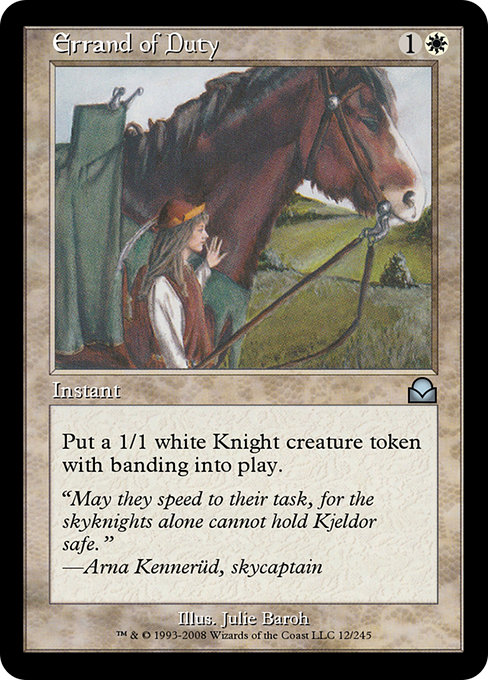
Image courtesy of Scryfall.com
Meta-Aware Card Design in the Commander Space: Lessons from Errand of Duty
Magic: The Gathering has always thrived on the tension between broad accessibility and deep, meta-aware design. In Commander, that tension is amplified: players draft giant boards, wrangle with political dynamics, and savor the micro-judgments that decide who gets to lead the table. Errand of Duty, a two-mana white instant from Masters Edition II, stands as an elegant early example of how a single spell can shape the tempo of a game while hinting at the complexities future designers might embrace. 🧙♂️🔥💎
With the mana cost of {1}{W}, Errand of Duty asks you to invest a tiny bit of white’s canonical toolkit—order, duty, and the protection of the realm—and convert it into a tangible threat on the battlefield: a 1/1 white Knight creature token with banding. The token’s existence is more than a numbers game. Banding, a combat mechanic rarely seen in the modern era, invites a mix of strategy and theater. In practical terms, you can group your Knight with other banding creatures (and potentially one additional Knight or non-band creature) to orchestrate how damage is distributed. It’s a mechanic that rewards careful planning and can swing a late-game standoff in ways that standard creature combat often cannot. This is the kind of design that invites meta-awareness—the card isn’t just about what it does in a vacuum, but how it can shape the combat calculus when the table is staring down a tide of tokens, removal, or political maneuvering. ⚔️🎲
“May they speed to their task, for the skyknights alone cannot hold Kjeldor safe.” —Arna Kennerüd, skycaptain
Errand of Duty’s flavor text anchors white’s long-running duty-bound ethos and reaffirms the card’s historical context in the wider Kjeldoran narrative. The line, delivered by the skycaptain Arna Kennerüd, offers a window into why a simple spell—an instant that spawns a single knight—mattered in a world where battles could hinge on who controlled the skies and who controlled the tempo of play. The art by Julie Baroh (a masterful touch in Masters Edition II) captures that sense of duty under pressure, a reminder that meta-aware design is as much about storytelling as it is about math. 🎨
From a design perspective, Errand of Duty is a lens into how tokens can become economic engines in Commander. The 1/1 Knight token is not a flashy bomb; rather, it’s a modular unit that can synergize with white’s common archetypes—KO effects, anthem buffs, and keyword expansion—while also playing into the variable of banding. Banding, in particular, creates an environment where players must think not just about damage, but about how that damage is allocated among multiple attackers or blockers. In a Commander setting, where games spike in complexity due to multiple players and evolving board states, such mechanics can escalate decision trees, prompting thoughtful play rather than rote execution. 🧙♂️🔥
In the broader catalog, Errand of Duty sits within Masters Edition II, a reprint-heavy Masters set that remembered the game’s roots while nudging players toward fresh, if occasionally perplexing, combat dynamics. As a two-mana white instant, it slots neatly into tempo or defensive game plans, allowing a player to tempo the board with a quick token wave or set up banding-enabled combat tricks for the next turn. Its rarity—uncommon—hints at a careful balance: not a must-pick bomb, but a flexible tool that rewards foresight. The card’s legality in Commander (and other casual formats) underscores the enduring role of token generation in the meta, especially in multiplayer environments where alliance shifts can hinge on who controls the board’s tempo. Such design choices foreshadow how future meta-aware cards might be tuned for broader formats without sacrificing depth. 🧠🧙♂️
Looking ahead, how might designers push meta-awareness further without sacrificing clarity? One path is to evolve token archetypes—beyond the classic 1/1 bodies—to tokens with built-in, optional sub-abilities that trigger under certain combat configurations. Another path is to weave mechanics that explicitly reward or punish banding in ways that feel intuitive to newer players while still rewarding expert play. Errand of Duty demonstrates that even a modest spell can carry outsized strategic value if the token’s existence interacts with broader combat choices. In a modern Commander landscape, we might imagine keyword-sparse but effect-dense spells that reveal their power through context: a spell that creates a knight with banding, but only if you control a board with two or more knights; or a spell that interacts with fog effects to form winged squadrons that pressure opponents in a political dance. The possibilities for meta-aware card design are as expansive as the table at a weekly Commander night. 🧙♂️🎲
For collectors and players who savor the lore and the art, Errand of Duty reminds us that behind every token there’s a design philosophy at work: the balance between simplicity and sophistication, the tension between tempo and protection, and the joy of discovering a nuanced interaction that reshapes a game’s narrative arc. The token’s line—“Create a 1/1 white Knight creature token with banding”—is almost a microcosm of modern design: compact, specific, and capable of spawning expansive play patterns when framed by the rest of a table’s board state. And in Commander, that potential multiplier effect makes Errand of Duty feel timeless, even as new sets push design into bolder, more meta-aware frontiers. 💎
Product spotlight
While we explore the future of card design, a tactile reminder that great game accessories can accompany collecting and play. Check out Neon Slim Phone Case: Ultra-thin Glossy Lexan PC for a sleek, protective companion to your gaming rig or play space. Neon Slim Phone Case Ultra-thin Glossy Lexan PC
More from our network
- https://crypto-acolytes.xyz/blog/post/outer-wilds-vs-outer-worlds-which-scifi-adventure-reigns/
- https://blog.digital-vault.xyz/blog/post/intertextuality-in-mtg-apostle-of-invasions-hidden-echoes/
- https://blog.digital-vault.xyz/blog/post/decoding-color-psychology-in-alter-reality-mtg-art/
- https://crypto-acolytes.xyz/blog/post/from-nfts-to-play-to-earn-crypto-gaming-trends/
- https://blog.digital-vault.xyz/blog/post/mystic-zealot-powering-white-aggro-decks/